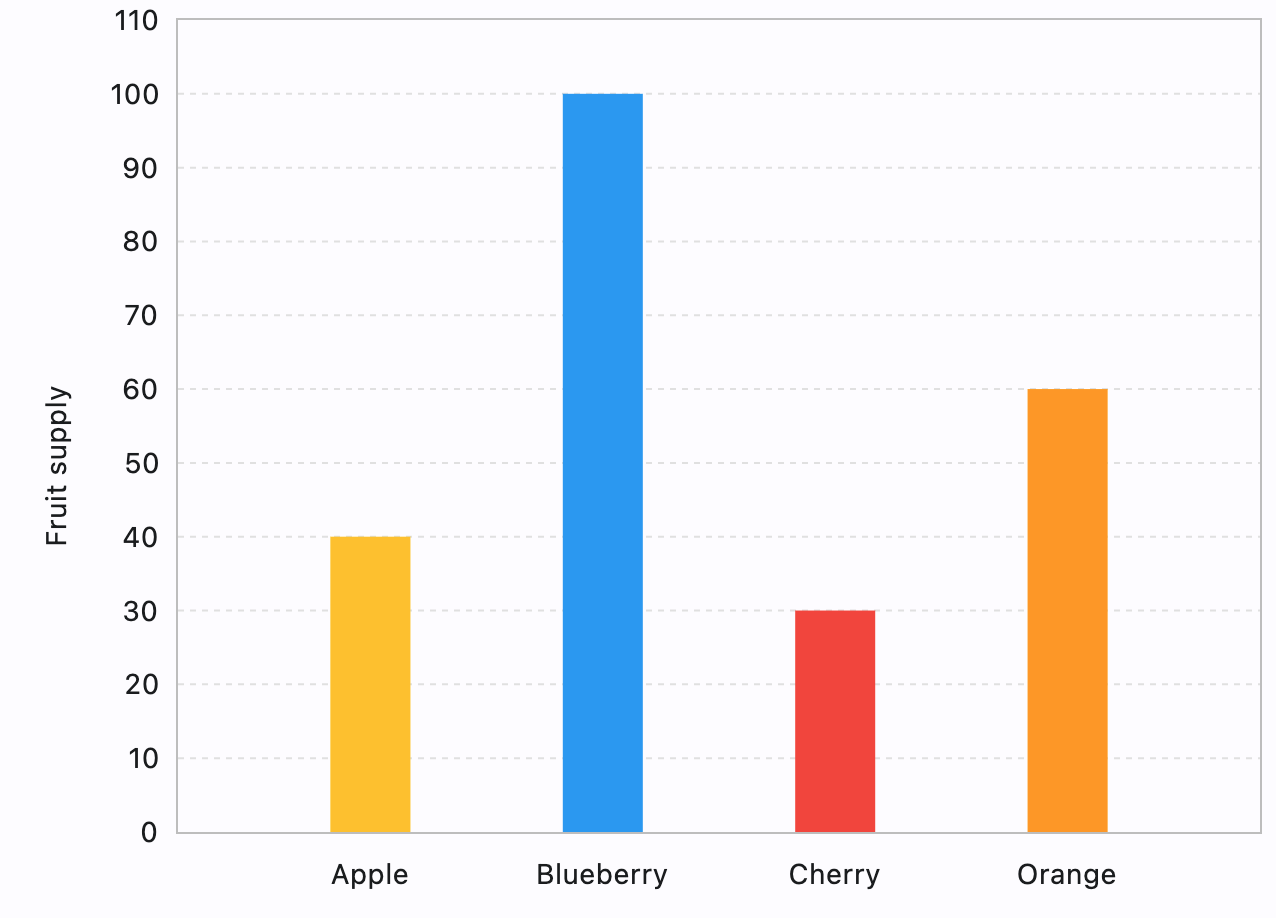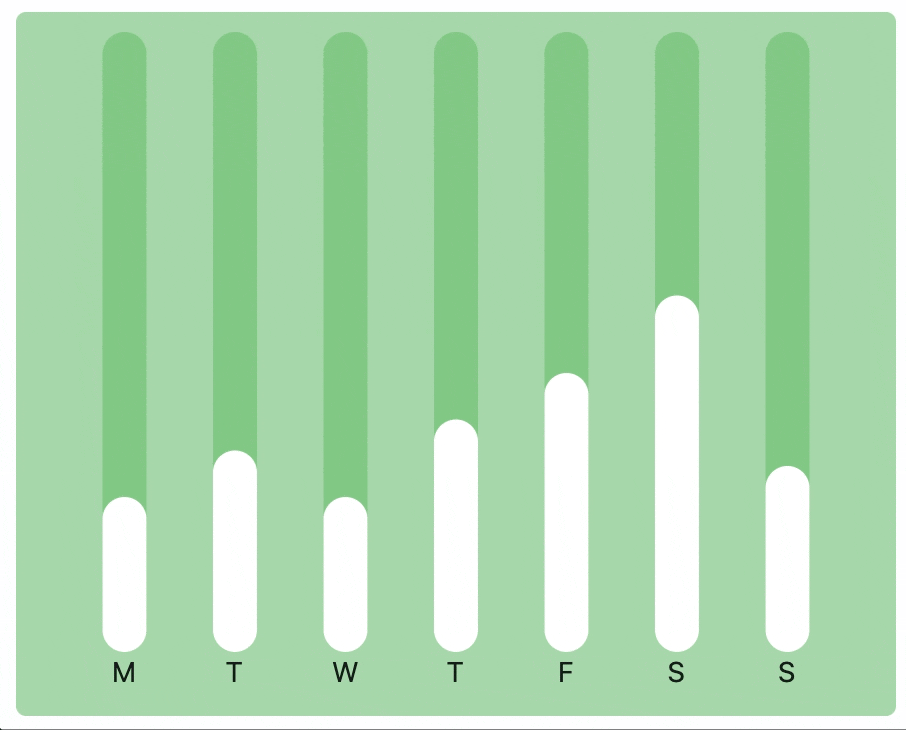BarChart
Inherits: LayoutControl
Properties
-
animation(AnimationValue) –Controls chart implicit animation.
-
baseline_y(Number | None) –Baseline value for Y axis.
-
bgcolor(ColorValue | None) –Background color of the chart.
-
border(Border | None) –The border around the chart.
-
bottom_axis(ChartAxis) –The appearance of the bottom axis, its title and labels.
-
group_alignment(MainAxisAlignment) –A alignment of the bar
groupswithin this chart. -
group_spacing(Number) –A amount of space between bar
groups. -
groups(list[BarChartGroup]) –The list of
BarChartGroups to draw. -
horizontal_grid_lines(ChartGridLines | None) –Controls drawing of chart's horizontal lines.
-
interactive(bool) –Enables automatic tooltips when hovering chart bars.
-
left_axis(ChartAxis) –The appearance of the left axis, its title and labels.
-
max_y(Number | None) –The maximum displayed value for Y axis.
-
min_y(Number | None) –The minimum displayed value for Y axis.
-
right_axis(ChartAxis) –The appearance of the right axis, its title and labels.
-
tooltip(BarChartTooltip | None) –The tooltip configuration for this chart.
-
top_axis(ChartAxis) –The appearance of the top axis, its title and labels.
-
vertical_grid_lines(ChartGridLines | None) –Controls drawing of chart's vertical lines.
Events
-
on_event(EventHandler[BarChartEvent] | None) –Called when an event occurs on this chart, such as a click or hover.
Examples#
Example 1#
import flet as ft
import flet_charts as fch
def main(page: ft.Page):
page.add(
fch.BarChart(
expand=True,
interactive=True,
max_y=110,
border=ft.Border.all(1, ft.Colors.GREY_400),
horizontal_grid_lines=fch.ChartGridLines(
color=ft.Colors.GREY_300, width=1, dash_pattern=[3, 3]
),
tooltip=fch.BarChartTooltip(
bgcolor=ft.Colors.with_opacity(0.5, ft.Colors.GREY_300),
border_radius=ft.BorderRadius.all(20),
),
left_axis=fch.ChartAxis(
label_size=40, title=ft.Text("Fruit supply"), title_size=40
),
right_axis=fch.ChartAxis(show_labels=False),
bottom_axis=fch.ChartAxis(
label_size=40,
labels=[
fch.ChartAxisLabel(
value=0, label=ft.Container(ft.Text("Apple"), padding=10)
),
fch.ChartAxisLabel(
value=1, label=ft.Container(ft.Text("Blueberry"), padding=10)
),
fch.ChartAxisLabel(
value=2, label=ft.Container(ft.Text("Cherry"), padding=10)
),
fch.ChartAxisLabel(
value=3, label=ft.Container(ft.Text("Orange"), padding=10)
),
],
),
groups=[
fch.BarChartGroup(
x=0,
rods=[
fch.BarChartRod(
from_y=0,
to_y=40,
width=40,
color=ft.Colors.GREEN,
border_radius=0,
),
],
),
fch.BarChartGroup(
x=1,
rods=[
fch.BarChartRod(
from_y=0,
to_y=100,
width=40,
color=ft.Colors.BLUE,
tooltip=fch.BarChartRodTooltip("Blueberry"),
border_radius=0,
),
],
),
fch.BarChartGroup(
x=2,
rods=[
fch.BarChartRod(
from_y=0,
to_y=30,
width=40,
color=ft.Colors.RED,
border_radius=0,
),
],
),
fch.BarChartGroup(
x=3,
rods=[
fch.BarChartRod(
from_y=0,
to_y=60,
width=40,
color=ft.Colors.ORANGE,
tooltip=fch.BarChartRodTooltip("Orange"),
border_radius=0,
),
],
),
],
)
)
ft.run(main)
Example 2#
import flet as ft
import flet_charts as fch
class CustomRod(fch.BarChartRod):
def __init__(self, y: float, hovered: bool = False):
super().__init__()
self.hovered = hovered
self.y = y
self.width = 22
self.color = ft.Colors.WHITE
self.bg_to_y = 20
self.bg_color = ft.Colors.GREEN_300
def before_update(self):
super().before_update()
self.to_y = self.y + 0.5 if self.hovered else self.y
self.color = ft.Colors.YELLOW if self.hovered else ft.Colors.WHITE
self.border_side = (
ft.BorderSide(width=1, color=ft.Colors.RED)
if self.hovered
else ft.BorderSide(width=1, color=ft.Colors.BLUE)
)
def main(page: ft.Page):
def on_chart_event(e: fch.BarChartEvent):
if e.type == fch.ChartEventType.POINTER_HOVER:
for group_index, group in enumerate(chart.groups):
for rod_index, rod in enumerate(group.rods):
rod.hovered = (
e.group_index == group_index and e.rod_index == rod_index
)
chart.update()
chart = fch.BarChart(
on_event=on_chart_event,
interactive=True,
groups=[
fch.BarChartGroup(x=0, rods=[CustomRod(5)]),
fch.BarChartGroup(x=1, rods=[CustomRod(6.5)]),
fch.BarChartGroup(x=2, rods=[CustomRod(15)]),
fch.BarChartGroup(x=3, rods=[CustomRod(7.5)]),
fch.BarChartGroup(x=4, rods=[CustomRod(9)]),
fch.BarChartGroup(x=5, rods=[CustomRod(11.5)]),
fch.BarChartGroup(x=6, rods=[CustomRod(6)]),
],
bottom_axis=fch.ChartAxis(
labels=[
fch.ChartAxisLabel(value=0, label=ft.Text("M", color=ft.Colors.BLUE)),
fch.ChartAxisLabel(value=1, label=ft.Text("T", color=ft.Colors.YELLOW)),
fch.ChartAxisLabel(value=2, label=ft.Text("W", color=ft.Colors.BLUE)),
fch.ChartAxisLabel(value=3, label=ft.Text("T", color=ft.Colors.YELLOW)),
fch.ChartAxisLabel(value=4, label=ft.Text("F", color=ft.Colors.BLUE)),
fch.ChartAxisLabel(value=5, label=ft.Text("S", color=ft.Colors.YELLOW)),
fch.ChartAxisLabel(value=6, label=ft.Text("S", color=ft.Colors.BLUE)),
],
),
)
page.add(
ft.Container(
content=chart,
bgcolor=ft.Colors.GREEN_200,
padding=10,
border_radius=5,
expand=True,
)
)
ft.run(main)
Properties#
animation: AnimationValue = field(
default_factory=lambda: Animation(
duration=Duration(milliseconds=150), curve=LINEAR
)
)
Controls chart implicit animation.
The appearance of the bottom axis, its title and labels.
group_alignment: MainAxisAlignment = SPACE_EVENLY
A alignment of the bar groups within this chart.
If set to MainAxisAlignment.CENTER,
the space between the groups can be specified using group_spacing.
groups: list[BarChartGroup] = field(default_factory=list)
The list of BarChartGroups to draw.
horizontal_grid_lines: ChartGridLines | None = None
Controls drawing of chart's horizontal lines.
The appearance of the left axis, its title and labels.
The appearance of the right axis, its title and labels.
tooltip: BarChartTooltip | None = field(
default_factory=lambda: BarChartTooltip()
)
The tooltip configuration for this chart.
If set to None, tooltips will not shown throughout this chart.
The appearance of the top axis, its title and labels.
vertical_grid_lines: ChartGridLines | None = None
Controls drawing of chart's vertical lines.
Events#
on_event: EventHandler[BarChartEvent] | None = None
Called when an event occurs on this chart, such as a click or hover.

